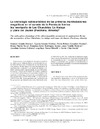Please use this identifier to cite or link to this item:
https://accedacris.ulpgc.es/jspui/handle/10553/59905
| Title: | La cronología radiocarbónica de las primeras manifestaciones megalíticas en el sureste de la Península Ibérica: las necrópolis de Las Churuletas, La Atalaya y Llano del Jautón (Purchena, Almería) | Authors: | Aranda Jiménez, Gonzalo Lozano Medina, Agueda Cámalich Massieu, María Dolores Martín Socas, Dimas Rodríguez Santos, Francisco Javier Trujillo Mederos, Aioze Santana Cabrera, Jonathan Nonza Micaelli, Angélique Clop García, Xavier |
UNESCO Clasification: | 550405 Prehistoria | Keywords: | Neolítico Edad del Cobre Cronología Datación radiocarbónica Modelado Bayesiano, et al |
Issue Date: | 2017 | Journal: | Trabajos de Prehistoria | Abstract: | Por primera vez en el estudio del fenómeno megalítico
del sureste de la Península Ibérica se ha obtenido una serie
radiocarbónica para el análisis de sus manifestaciones
más antiguas. Se han datado 30 restos antropológicos de
sepulturas tipo rundgräber y de tumbas de cámara y corredor
pertenecientes a las necrópolis de Las Churuletas,
La Atalaya y Llano de El Jautón. El análisis estadístico
de esta serie radiocarbónica ha permitido establecer las
siguientes conclusiones: i) el inicio de la actividad funeraria
ocurriría entre el 3730-3650 cal BC y el final entre el
2395-2270 cal BC; ii) las sepulturas tipo rundgräber son
las que poseen una duración más corta, finalizando entre
el 2650-2505 cal BC; iii) la datación de diferentes sepulturas
y necrópolis muestra una importante heterogeneidad
en sus periodos de uso; y iv) a partir de principios del III
milenio se produciría una significativa intensificación de
la actividad funeraria paralela al incremento demográfico
y desarrollo del poblamiento. For the first time in the study of the southeastern Iberian megalithic phenomenon, a series of 30 radiocarbon dates has been obtained for some of the oldest monuments. Two types of tombs, circular chambers (rundgräber) and graves with chamber and passage, from three necropolises, Las Churuletas, La Atalaya and El Llano de El Jautón, have been dated using human remains. Four main conclusion can be drawn from the statistical analysis of this radiocarbon series: i) the beginning of funeral activity occured between 3730-3650 cal BC and the end between 2395-2270 cal BC; ii) the rundgräber are the type of tomb with shorter duration, ending between 2650-2505 cal BC; iii) the dating of different graves and necropolises shows an important heterogeneity in their periods of use; and iv) from the beginning of the 3rd millennium, there is a strong intensification of funerary activity along with an crease population size and the number of settlements. |
URI: | https://accedacris.ulpgc.es/handle/10553/59905 | ISSN: | 0082-5638 | Source: | Trabajos de prehistoria [ISSN 0082-5638],v. 74 (2), p. 257-277 | URL: | http://dialnet.unirioja.es/servlet/articulo?codigo=6262944 |
| Appears in Collections: | Artículos |
Page view(s)
140
checked on Feb 22, 2025
Download(s)
154
checked on Feb 22, 2025
Google ScholarTM
Check
Share
Export metadata
Items in accedaCRIS are protected by copyright, with all rights reserved, unless otherwise indicated.
